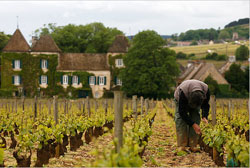From the NY Times
 When Thomas Jefferson embarked on his grand tour of France in 1787, he
claimed the journey was for his health. A broken wrist sent him 1,200
miles south from Paris to take the mineral waters at Aix-en-Provence, and on the way he
planned to fulfill his professional obligations as America’s top envoy
to France, researching French architecture, agriculture and engineering
projects.
When Thomas Jefferson embarked on his grand tour of France in 1787, he
claimed the journey was for his health. A broken wrist sent him 1,200
miles south from Paris to take the mineral waters at Aix-en-Provence, and on the way he
planned to fulfill his professional obligations as America’s top envoy
to France, researching French architecture, agriculture and engineering
projects.
But when he chose to begin his three-month journey in the vine-covered slopes of Burgundy, Jefferson’s daughter, Martha, became suspicious. “I am inclined to think that your voyage is rather for your pleasure than for your health,” she teased him in a letter.
In fact, Jefferson’s five-day visit to the Côte d’Or — a region famous even in the 18th century for its extraordinary terroir — was not accidental. After spending more than two years in Paris establishing diplomatic relations with the court of Louis XVI, Jefferson, a lifelong oenophile, had tasted his share of remarkable vintages. Now he was keen to discover the vineyards and cellars of Burgundy, and to study firsthand a winemaking tradition that stretched back to the 11th century.
“I rambled thro’ their most celebrated vineyards, going into the houses of the laborers, cellars of the vignerons, and mixing and conversing with them as much as I could,” Jefferson wrote about the winemakers in a letter posted during his trip.
